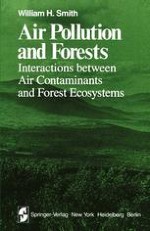1981 | OriginalPaper | Chapter
Class II Summary: Forest Responds by Exhibiting Alterations in Growth, Biomass, Species Composition, Disease, and Insect Outbreaks
Author : William H. Smith
Published in: Air Pollution and Forests
Publisher: Springer US
Included in: Professional Book Archive
Activate our intelligent search to find suitable subject content or patents.
Select sections of text to find matching patents with Artificial Intelligence. powered by
Select sections of text to find additional relevant content using AI-assisted search. powered by
In the presence of a sufficient dose of an air pollutant, forest trees will be adversely impacted. When this occurs the threshold between Class I and Class II interactions is crossed. At intermediate dose, the specific contaminant concentration and time of exposure varying greatly with specific pollutant and forest situation, the influence on individual forest components may range from extremely subtle to visibly dramatic. Chapters 7 through 14 have reviewed the evidence available to support the hypotheses that intermediate air pollution loads may alter or inhibit forest tree reproduction, alter forest nutrient cycling, alter tree metabolism, or change forest stress conditions by influencing insect pests, microbial pathogens, and by directly damaging foliar tissue. All but the latter of these impacts would be extremely subtle, visibly asymptomatic, and detectable only by very careful forest monitoring.
